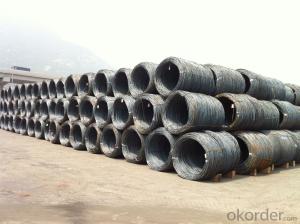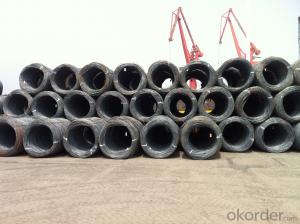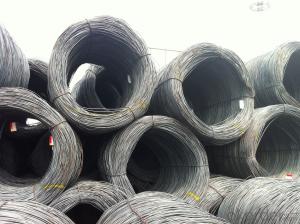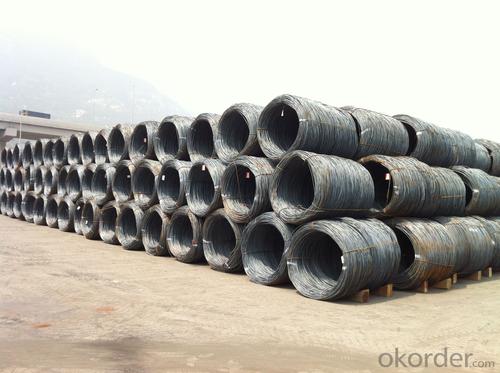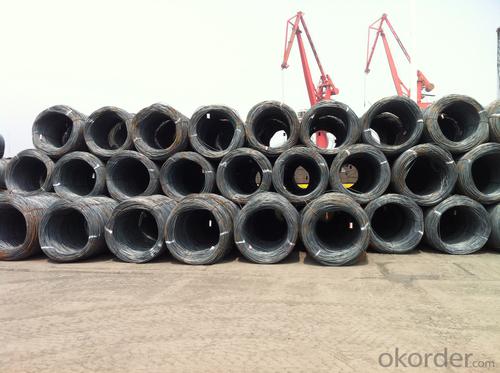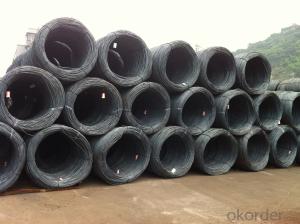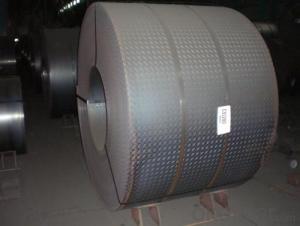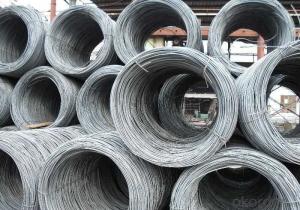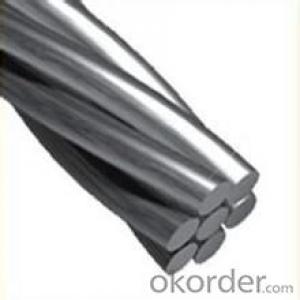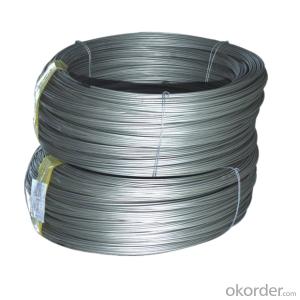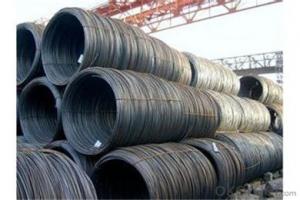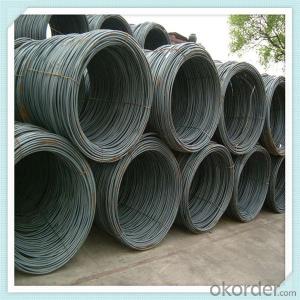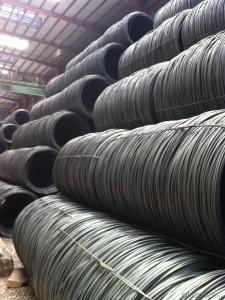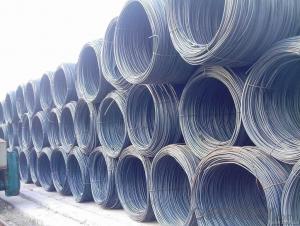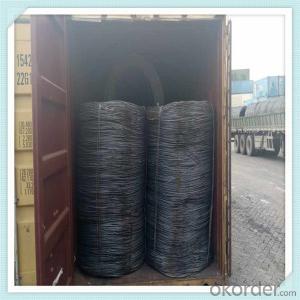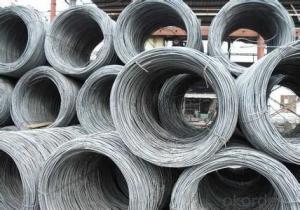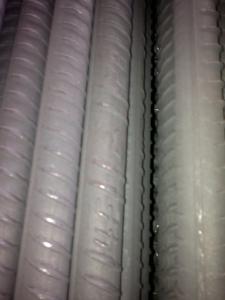Steel Wire rods with Grade SAE1006-1018 in Best Quality
- Loading Port:
- Tianjin
- Payment Terms:
- TT OR LC
- Min Order Qty:
- 25 m.t
- Supply Capability:
- 20000 m.t/month
OKorder Service Pledge
OKorder Financial Service
You Might Also Like
OKorder is offering Carbon Steel Wire Rod at great prices with worldwide shipping. Our supplier is a world-class manufacturer of steel, with our products utilized the world over. OKorder annually supplies products to European, North American and Asian markets. We provide quotations within 24 hours of receiving an inquiry and guarantee competitive prices.
Product Applications:
After hot-rolled the products shaped into coil and delivery as finished product, including round, square, rectangular, hexagonal and so on. Since most of the products are round, it is generally called wire rod. Carbon steel wire rod is widely used in construction and manufacturing. Carbon steel wire rod is mainly used for reinforcement of reinforced concrete and welded structure or reprocessed (roberts , nail, etc.) materials, especially used to produce wire drawing, welding electrode, nails, spring, electronic, precise machinery parts and so on.
Product Advantages:
OKorder's Carbon Steel Wire Rod are durable, strong, and resist corrosion.
Main Product Features:
· Premium quality
· Prompt delivery & seaworthy packing (30 days after receiving deposit)
· Corrosion resistance
· Can be recycled and reused
· Mill test certification
· Professional Service
· Competitive pricing
Product Specifications:
Chemical Composition:
Please kindly find our chemistry of our material based on SAE1006/SAE1008 as below for your information
Grade | Chemical Composition (%) | |||||
C | Mn | S | P | Si | B | |
SAE1006 | 0.03~O.07 | 0.32max | 0.045max | 0.040max | 0.30max | 0.0008min |
Mechanical properties | ||||||
Yield strength(N/mm2) | Tensile strength(N/mm2) | Elongation (%) | ||||
250-280 | 350-380 | ≥32 | ||||
Grade | Chemical Composition (%) | |||||
C | Mn | S | P | Si | B | |
SAE1008 | 0.10max | 0.3~0.50 | 0.050max | 0.040 max | 0.15max | 0.0008 min |
Mechanical properties | ||||||
Yield strength(N/mm2) | Tensile strength(N/mm2) | Elongation (%) | ||||
≥195 | 315-430 | ≥30 | ||||
FAQ:
Q1: Why buy Materials & Equipment from OKorder.com?
A1: All products offered byOKorder.com are carefully selected from China's most reliable manufacturing enterprises. Through its ISO certifications, OKorder.com adheres to the highest standards and a commitment to supply chain safety and customer satisfaction.
Q2: What's your shipment type ?
A2: Usually we ship the goods by bulk vessel,if you want load them by container vessels,we can arrange as well .
Q3:What's your payment terms ?
A3:Mostly,we collect the money by T/T and LC at sight .
Images:
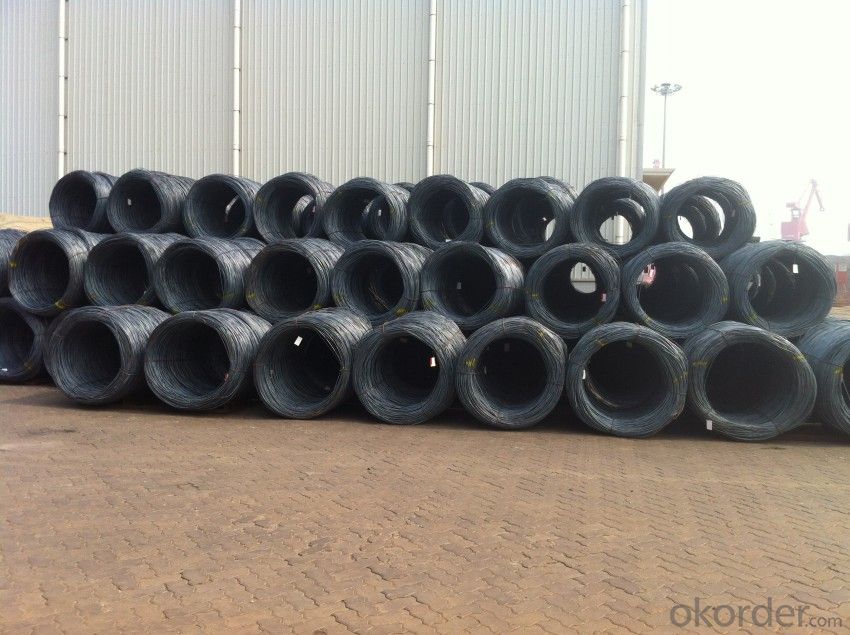
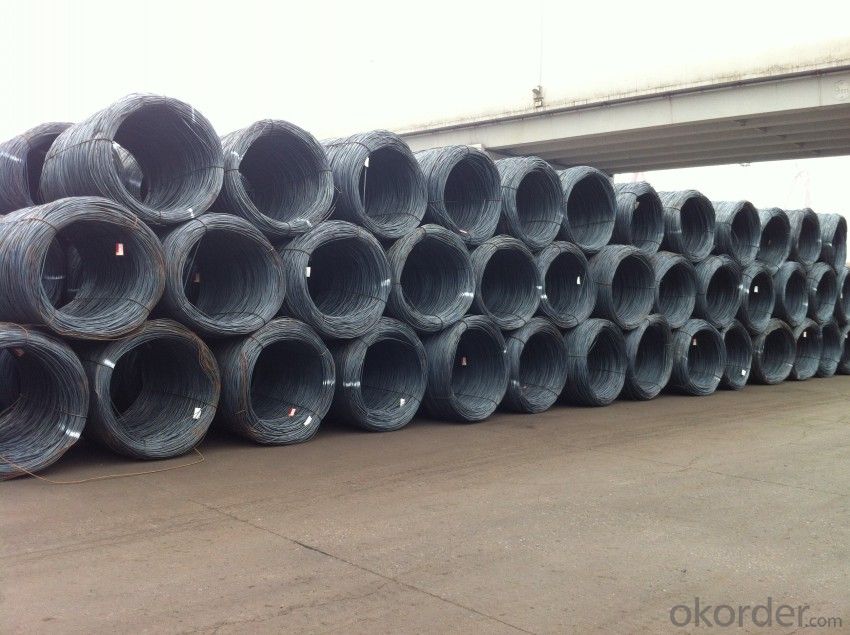
- Q: What are the different types of steel wire rod surface cleaning methods for wire drawing?
- In the wire drawing process, various methods are commonly employed to clean the surface of steel wire rods. These methods play a vital role in eliminating impurities and ensuring a polished and superior final product. 1. Acid Pickling: Acid pickling is extensively utilized to clean steel wire rod surfaces. This technique involves immersing the wire rod in a solution of hydrochloric acid, which effectively eliminates rust, scale, and oxide layers. By removing surface impurities, acid pickling prepares the wire rod for subsequent wire drawing processes. 2. Electrolytic Cleaning: Another prevalent method for purifying steel wire rod surfaces is electrolytic cleaning. This process entails passing an electric current through the wire rod submerged in an electrolytic solution. The current effectively dissolves and separates contaminants from the wire rod surface. Electrolytic cleaning is especially effective in eliminating oils, greases, and other organic substances. 3. Mechanical Cleaning: Mechanical cleaning involves physically scrubbing and cleaning the wire rod surface using abrasive materials or brushes. This technique can be performed manually or with specialized machinery. Mechanical cleaning is highly efficient in removing stubborn dirt, rust, and scale from the wire rod. 4. Shot Blasting: Shot blasting is a process that involves propelling small metallic or non-metallic particles onto the wire rod surface at high velocities. The impact of these particles effectively eliminates surface contaminants, scale, and rust. Shot blasting is particularly useful for cleaning wire rods with intricate shapes or hard-to-reach areas. 5. Ultrasonic Cleaning: Ultrasonic cleaning employs high-frequency sound waves to generate tiny bubbles in a cleaning solution. These bubbles collapse upon contact with the wire rod surface, creating a scrubbing action that removes contaminants. Ultrasonic cleaning is highly effective in eliminating fine particles, oils, and greases. Each of these steel wire rod surface cleaning methods possesses its own advantages and limitations. The selection of the appropriate method depends on various factors, such as the type of contaminants, wire rod composition, and desired level of cleanliness. Choosing the right cleaning method is crucial to achieve optimal wire drawing performance and produce high-quality wire products.
- Q: What are the different packaging options available for steel wire rod?
- There are several different packaging options available for steel wire rods, depending on the specific requirements and preferences of the customers. Some of the common packaging options include: 1. Coils: Steel wire rods can be packaged in coil form, where the rod is wound into a circular shape. Coils are commonly used for smaller diameter wire rods and are often wrapped in plastic or paper to protect them from corrosion and damage during transportation. 2. Bundles: Larger diameter steel wire rods are often packaged in bundles. In this packaging option, multiple rods are tied together using straps or wire and wrapped in protective materials such as plastic or paper. Bundles allow for easy handling and transportation of the wire rods. 3. Pallets: Steel wire rods can also be packaged on pallets, particularly when large quantities are being shipped. The rods are arranged on a wooden or plastic pallet and secured using straps or stretch film. Pallets provide stability and ease of storage and handling. 4. Reels: For specific applications, steel wire rods may be packaged on reels. This packaging option is commonly used for wire rods that are intended for use in the manufacturing of cables or wires. The rods are wound onto a reel, which can be made of wood, plastic, or metal, and often come with flanges to prevent tangling. 5. Customized Packaging: In some cases, customers may require customized packaging options for their steel wire rods. This can include specific labeling, marking, or additional protective measures to meet their specific needs. Manufacturers and suppliers can work with customers to develop tailored packaging solutions. Overall, the choice of packaging option for steel wire rods depends on factors such as the diameter of the rods, the quantity being shipped, and the specific requirements of the customers. Manufacturers and suppliers can provide guidance and recommendations based on their expertise and experience in the industry.
- Q: How does the fatigue strength of steel wire rod vary with different heat treatment processes?
- The fatigue strength of steel wire rod can vary significantly depending on the methods of heat treatment employed. Heat treatment involves subjecting the steel wire rod to specific heating and cooling processes in order to change its microstructure and mechanical properties. One commonly used heat treatment process to improve the fatigue strength of steel wire rod is quenching and tempering. This process includes heating the wire rod to a high temperature and then rapidly cooling it (quenching) to achieve a hardened microstructure. This leads to an increase in the fatigue strength of the wire rod because the hardened structure provides better resistance against fatigue failure. The subsequent tempering process involves reheating the wire rod to a lower temperature and slowly cooling it, which helps to relieve internal stresses and improve the toughness of the wire rod while maintaining an optimum balance of strength and ductility. On the other hand, if the steel wire rod undergoes a heat treatment process at a lower temperature, such as annealing, the fatigue strength may be reduced. Annealing involves heating the wire rod to a specific temperature and allowing it to cool slowly, often in a controlled atmosphere. This process is used to soften the wire rod, relieve internal stresses, and improve its machinability and formability. However, the resulting softer microstructure may cause a decrease in fatigue strength compared to quenched and tempered wire rod. In conclusion, the fatigue strength of steel wire rod can be improved through heat treatment processes like quenching and tempering, which lead to a hardened microstructure. Conversely, heat treatment processes like annealing can decrease the fatigue strength by producing a softer microstructure. Therefore, the selection of heat treatment processes is crucial in determining the fatigue strength of steel wire rod.
- Q: How is steel wire rod used in the manufacturing of wire forms for automotive suspension systems?
- Steel wire rod is used in the manufacturing of wire forms for automotive suspension systems as it provides strength and durability. The wire rod is typically shaped and bent into various forms such as springs, torsion bars, and stabilizer bars, which are essential components of suspension systems. These wire forms absorb shocks and vibrations, ensuring a smooth and stable ride for the vehicle. Additionally, steel wire rod's high tensile strength allows the wire forms to withstand heavy loads and maintain their shape over time, contributing to the overall performance and safety of the suspension system.
- Q: What are the alloying elements used in steel wire rod production?
- The alloying elements used in steel wire rod production can vary depending on the desired properties of the final product. However, some common alloying elements used in this process include carbon, manganese, silicon, and sometimes chromium, nickel, or molybdenum. Carbon is one of the most important alloying elements in steel wire rod production as it enhances the strength and hardness of the steel. The carbon content is typically kept within a specific range to achieve the desired mechanical properties. Manganese is another commonly used alloying element in steel wire rod production. It helps improve the strength and toughness of the steel and also enhances its hardenability during the heat treatment process. Silicon is often added to the steel to improve its resistance to oxidation and to enhance its electrical conductivity. It can also help control the grain size of the steel, which affects its mechanical properties. In some cases, chromium is added to steel wire rod to improve its corrosion resistance and to enhance its hardenability. Nickel is another alloying element that can be used to increase the strength and toughness of the steel, while molybdenum can improve its high-temperature strength and creep resistance. It is important to note that the specific alloying elements and their concentrations used in steel wire rod production can vary depending on the specific requirements of the final application. Steel manufacturers carefully select and adjust these alloying elements to achieve the desired mechanical, electrical, and chemical properties in the wire rod.
- Q: How is steel wire rod used in the manufacturing of wire baskets for industrial applications?
- Steel wire rod is a primary material used in the manufacturing of wire baskets for industrial applications. It serves as the base material that is shaped, bent, and welded to create the framework of the basket. The high tensile strength and durability of steel wire rod make it ideal for withstanding heavy loads and rough handling in industrial environments. Additionally, the steel wire rod can be coated or galvanized to enhance corrosion resistance, ensuring longevity and reliable performance of the wire baskets.
- Q: How is steel wire rod classified based on its diameter?
- Steel wire rod is classified based on its diameter into various categories. The classification is typically done using a wire gauge system or by specifying the diameter directly in millimeters. The wire gauge system assigns a numerical value to different wire diameters, with higher numbers indicating thinner wires. For example, in the United States, the American Wire Gauge (AWG) system is commonly used. In this system, the thickest wire is assigned the gauge number 0000 (four zeros), while the thinnest wire has a gauge number of 40. Each gauge number corresponds to a specific diameter range. Alternatively, steel wire rod can also be classified based on its diameter in millimeters. This approach directly specifies the exact diameter of the wire rod, allowing for more precise classification. For example, a wire rod with a diameter of 5.5 mm would be classified as such. Both methods of classification provide a standardized way to categorize steel wire rod based on its diameter. This information is important for various industries that utilize steel wire rod, such as construction, automotive, and manufacturing, as it allows them to select the appropriate wire rod for their specific applications.
- Q: What are the disadvantages of using steel wire rod in manufacturing?
- There are several disadvantages of using steel wire rods in manufacturing: 1. Corrosion: Steel wire rods are susceptible to corrosion, especially when exposed to moisture or chemical substances. This can lead to a decrease in the durability and lifespan of the manufactured products. 2. Weight: Steel wire rods are relatively heavier compared to other materials such as aluminum or carbon fiber. This can make the manufacturing process more labor-intensive and increase transportation costs. 3. Limited flexibility: Steel wire rods have lower flexibility compared to other materials. This can limit the design possibilities and functionality of the manufactured products, especially in industries where flexibility is crucial, such as automotive or aerospace. 4. Cost: Steel wire rods can be more expensive compared to other materials used in manufacturing. This is particularly true when the demand for steel is high, leading to increased prices. Additionally, the manufacturing process for steel wire rods can involve several steps, which can further add to the production costs. 5. Environmental impact: The production of steel wire rods involves the extraction of iron ore, which can have a significant environmental impact. The extraction process can result in deforestation, habitat destruction, and pollution. Additionally, the manufacturing process for steel requires a substantial amount of energy, contributing to greenhouse gas emissions. 6. Maintenance: Steel wire rods may require regular maintenance to prevent corrosion, such as applying protective coatings or implementing proper storage methods. This can add to the overall costs and time required for product maintenance. 7. Electrical conductivity: Steel wire rods have relatively poor electrical conductivity compared to other materials, such as copper or aluminum. This can limit their usability in certain industries or applications where electrical conductivity is essential, such as electronics or electrical wiring. Overall, while steel wire rods have several advantages in manufacturing, including strength and rigidity, they also have notable disadvantages that need to be considered when selecting materials for manufacturing processes.
- Q: What is the difference between hot rolled and cold drawn steel wire rod?
- Hot rolled steel wire rod is produced by passing a heated billet through a series of rolling mills, resulting in a larger diameter and a rougher surface finish. On the other hand, cold drawn steel wire rod is formed by pulling a hot rolled wire rod through a die at room temperature, resulting in a smaller diameter and a smoother surface finish.
- Q: Round in high wire and ordinary line what is the difference?
- The universal wire and high speed wire are the wire rods (bars) of the rolling mechanism.High wire: refers to the use of high-speed torsion mill rolling wire rod. The rolling speed of 80-160 M / s, each weight (disc) in 1.8-2.5 tons, tolerance of high precision (up to 0.02mm), in the rolling process by adjusting the process parameters (especially in the cooling line) to ensure the different requirements for the product.
Send your message to us
Steel Wire rods with Grade SAE1006-1018 in Best Quality
- Loading Port:
- Tianjin
- Payment Terms:
- TT OR LC
- Min Order Qty:
- 25 m.t
- Supply Capability:
- 20000 m.t/month
OKorder Service Pledge
OKorder Financial Service
Similar products
Hot products
Hot Searches
Related keywords
